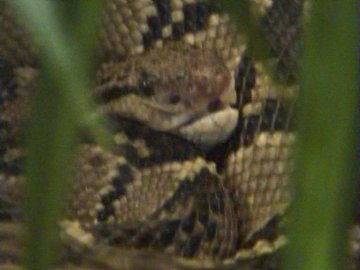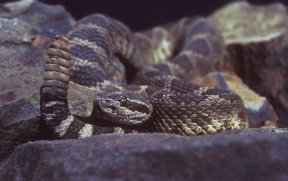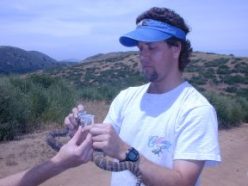Delivering a little snake venom
Poisonous snakes may control the amount of venom that they inject.
By Emily Sohn
I was hiking in the Costa Rican jungle a few years ago when I tripped on a root and twisted my ankle. Because the accident happened only about 20 minutes from the biological station where we were staying, I told my friends to keep going. I would limp back alone.
My head hung low as I hobbled back. I was in pain, and I was disappointed that I couldn’t finish the hike with everyone else. After a few minutes of limping and feeling sorry for myself, I heard a sudden rustling in the leaves near my right foot. There, not 5 feet away, was a bushmaster—one of Central and South America’s most venomous snakes. One strike from the 8-foot-long serpent, I knew, could spell disaster. Some 80 percent of bushmaster bites in Costa Rica lead to death.
 |
|
A glimpse of a bushmaster.
|
My heart pounded with terror as I backed away slowly, then turned and sped to safety.
The encounter remains one of the scariest experiences of my life. But some recent research has me reconsidering what I actually faced that day. It turns out that snakes can control how much venom they inject far better than most people give them credit for. Indeed, evidence is mounting that snakes and other venomous creatures may make complicated decisions, worthy of appreciation.
Venomous snakes
Of the 2,200-plus species of snakes in the world, fewer than 20 percent are venomous. Most of the ones that make the toxic goo use it to paralyze and digest their prey. Other times, they use it to defend themselves from attackers.
Scientists know a lot about the chemistry of venoms, which differ among species. But they know much less about how animals use it in real-world situations. Studies are hard to do because bites usually happen so quickly and taking measurements tends to disturb the animals. Researchers often have to use fake arms and other models that can distort results.
One lingering question is whether snakes can control how much venom they inject when they strike. “I’ve been thinking about this for 15 years,” says Bill Hayes, a biologist at Loma Linda University in California, who points to both biological and ethical reasons for his interests. “If we make the basic assumption that animals don’t have the capacity to think or feel or make decisions—which is the overwhelming attitude scientists have had for decades—we don’t treat the animals well.”
Conserving venom
It would make sense if snakes could conserve their venom, Hayes says. Producing the poisonous substance probably requires quite a bit of energy, for one thing. And it may take days, even weeks, to replenish stores of depleted venom.
 |
|
The dangerous Northern Pacific rattlesnake (Crotalus viridis oreganus) is one of several poisonous snakes studied in the lab to learn how snakes use venom.
|
| © William K. Hayes |
The strongest support for his theory, Hayes says, comes from studies showing that rattlesnakes inject more venom into larger prey, regardless of how long the bite lasts. Other studies have shown variations based on how hungry the snake is and what kind of prey it’s attacking, among other factors.
Hayes’ newest work suggests that snakes may also be able to control their venom in cases of self-defense, an area that has been studied less than cases of attack. For one thing, Hayes says, a large percentage of attacks on people seem to be dry: The snakes don’t eject any venom at all. Maybe the snakes realize a scare in some situations is enough to get away.
 |
|
Bill Hayes extracts venom from an adult speckled rattlesnake (Crotalus mitchelli).
|
| © Shelton S. Herbert |
In one case, a snake struck three people who tried to grab it. The first person had fang marks but received no venom. The second victim got a large dose of venom. The third got only a little bit. Hayes thinks that some snakes can perceive the level of threat of an attacker and react accordingly. “They’re capable of making decisions,” Hayes says. “I’m very much convinced of that.”
Another view
Other experts are less sure. In a new paper, Bruce Young and colleagues at Lafayette College in Easton, Pa., argue that there’s little good evidence to support Hayes’ venom-control theory. They question assumptions about the amount of energy a snake uses to make venom. They point to evidence that snakes sometimes use way more venom than is needed to kill their prey. And, they say, just because snakes eject different amounts of venom in different situations does not mean that the snakes are consciously making those decisions.
Instead, Young’s group thinks that physical factors—like the size of the target, the texture of its skin, and angle of attack—matter most in determining how much venom a snake delivers.
Young’s paper has Hayes upset but even more convinced he’s right, especially in light of recent studies describing the complexities of venom control in scorpions, spiders, and other creatures.
As for me, I’ll never know if the bushmaster I met in Costa Rica consciously decided not to lash out at me. Maybe I just got lucky and caught him right after a big meal. Either way, I’m happy to be alive. I’ll let the experts figure out the rest.







